Content
- 1 The best self-fertile varieties for the Moscow region and the middle lane
- 2 Early winter-hardy and late cherry varieties
- 3 Yellow cherries that are not afraid of birds
- 4 Low-growing trees - small, but remote
- 5 Backyard yellow
- 6 Bereket
- 7 Goryanka
- 8 Tyutchevka
- 9 Dunn
- 10 Dolores
- 11 Pridonskaya
- 12 Tree height
- 13 Frost resistance
- 14 Pollination
- 15 Berry ripening time
- 16 Berry color
- 17 Shape and weight of the fetus
- 18 Choosing a fruitful cherry variety for the Moscow region
Foreword
There are many varieties of cherries today! In the south of Russia, more thermophilic trees are grown, and for the Moscow region and regions of the middle zone, it is better to choose frost-resistant plants. How not to get confused in the variety of cherry varieties and find the best one for your garden, we will tell in this article.
The best self-fertile varieties for the Moscow region and the middle lane
Self-fertility of varieties lies in the ability of fruit trees to self-pollinate with their pollen. Self-fertile are those that form 20-40% of the total number of flowers. Self-fertile varieties do not need cross-pollination with other varieties. Their advantage is that they are independent of the flight of pollinating insects.

Self-fertile cherry
But today there are not so many self-fertile varieties of sweet cherries. Therefore, even with such trees, it is better to plant pollinating varieties near them, which in any case will help to increase yields.
The best varieties of self-fertile cherries for the Moscow region today are recognized:
- Narodnaya Syubarova is considered the best option throughout Russia. True, one should not expect a huge harvest, 50 kilograms from one tree is the limit, it is no longer possible to harvest even in the most successful year. The berries of this sweet cherry are of medium size. The tree itself is tall, with a powerful trunk and branches that can withstand the load from snow or wind. The plant is highly self-pollinated, fruits ripen up to 90%. Saplings take root well and are able to grow even on sandy loam and loamy soils.
- Ovstuzhenka is a frost-resistant sweet cherry that can withstand up to -45 degrees, Conditionally self-fertile, since pollination takes place within one tree, the resulting ovaries are no more than 90%. Medium large berries, 4 to 7 grams. The yield is 30-50 kg per tree. The tree is not tall, which allows it to be grown on an industrial scale.
- Revna is a small plant with a pyramidal crown. Self-fertile, very fertile, not large-fruited, its berries are not large, but very sweet and aromatic. Cold-resistant, withstands frost down to -6 degrees during the flowering period. Possesses high transportability, shelf life for a long time, dense, not watery at the stage of maturity.
Early winter-hardy and late cherry varieties
Almost all known cherry varieties are mostly self-fertile, and only a few species are self-fertile, and then only partially, since they also require pollinator varieties for a full harvest. Therefore, when choosing a variety for planting in your garden, you need to immediately buy a pollinator plant with it in pair, which will have the same flowering period. Sweet cherry is divided into 3 groups according to flowering time.
Winter-hardy early cherry varieties:
- Iput - frost-resistant, has good fruits. Pollinators can be Revna and Raditsa.
- Home garden yellow - self-fertile variety, frost-resistant, vigorous, slow-fertile, quite fruitful. The berries are medium, sweet and sour.
- Gronkavaya is a strong, frost-resistant variety. The fruits received a high dessert rating. Suitable pollinators: Cheremashnaya, Raditsa, Iput, Fatezh and Ovstuzhenka.
- Red hill - less resistant to diseases, berries were highly appreciated. Pollinators, like Iput's.
- Ovstuzhenka - refers to partially self-fertile varieties, fruits with a good score. It is good to plant next to Iput cherries.
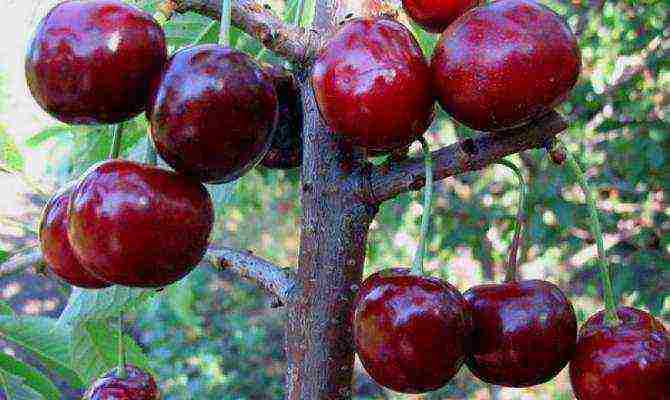
Winter-hardy cherry variety "Iput"
Mid-season cherry varieties:
- Rechitsa - belongs to the varieties of the bigarro group, frost-resistant, not large-fruited, with very sweet dark red berries. Disease resistant. From pollinators it is better to choose Pink Pearls, Adeline and Ovstuzhenka.
- Leningrad black from the guinea group. Sweet medium-sized berries, with pulp inseparable from the seeds. A tree of medium height, unstable to frost, not capable of self-pollination. Pollinators: Iput, Revna, Bryanochka, Tyutchevka and Veda.
- Leningrad pink - also belongs to the gini group. Small berries with a delicate, yellowish skin with ruddy barrels, the flesh is sweet and yellow. The plant is quite tall, has a lush crown, does not self-pollinate. It is recommended to plant next to the following varieties: Adelina, Chernyshevsky, Pink Pearl and Rechitsa.
- Tyutchevka is a medium-sized tree, very resistant to cold and disease. The berries are bright red, of medium size, well suited for freezing and transportation. The plant is partially self-pollinated. Recommended pollinators: Iput, Raditsa and Ovstuzhenka.
- Large-fruited - a tall, fast-growing tree with a broad-shaped crown of medium density. Large-fruited cherry has dark red berries, the weight of which is 10-12 grams, it is considered a dessert variety. The best pollinators will be Surprise and Oratovsky.
Late ripening varieties:
- Michurinka is not a tall tree that is resistant to drought and disease. The berries are dark red in color, strong, fleshy and sweet. Stored for a long time and well transported. The variety is self-fertile. Pollinators required: Michurinskaya late and Pink pearls.
- Bryansk pink - belongs to the bigarro group. The berries are medium-sized, about 5 grams, with sweet pink flesh that cannot be separated from the stone. For pollination, the following varieties are suitable: Iput, Revna, Ovstuzhenka and Tyutchevka.
Yellow cherries that are not afraid of birds
Red cherries, especially early varieties, are very fond of pecking birds. If the garden is located near the forest, rowan thrushes flying from it are capable of destroying the entire berry crop in a matter of hours. Therefore, it is better to cover the red-fruited varieties of the Moscow region with a net during the period of their fruiting.
Yellow cherries are not afraid of this misfortune - the birds do not touch its berries, and the harvest remains intact. In addition, red fruits do not tolerate heavy summer rains and often crack. The yellow cherry, in contrast to the red-sided cherry, does not have such a disadvantage.
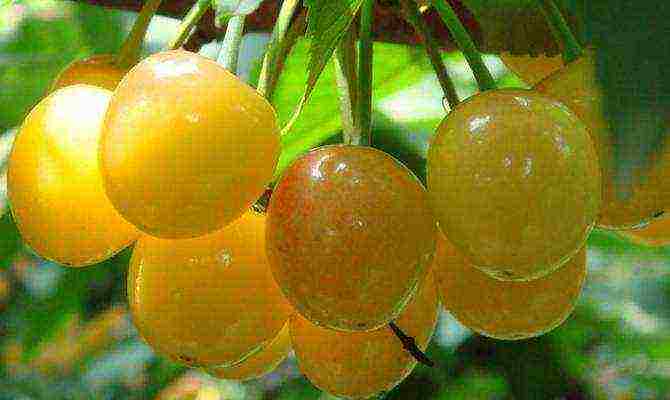
Yellow cherry
The most common cherry variety in the Moscow region is “Zheltaya Priusadebnaya”. She is from the early maturing varieties of the bigarro group. The berries are of medium size, weighing about 5-6 grams, their pulp, like the peel, is yellow, sweet, but with a slight sourness. Yellow Household loves black soil, so it takes root well in the middle lane.
Features of the variety:
- self-pollinated tree, has high yield rates;
- fruiting begins quite late - at the 6th year, while ordinary trees begin to bear fruit in the fourth year;
- frost-resistant variety, resistant to fungal diseases, not afraid of cherry flies;
- requires frequent pruning and removal of shoots, since the tree multiplies quickly and has a very lush crown.
Low-growing trees - small, but remote
To achieve high yields on a small planting area, columnar fruit trees are increasingly used, since there is less maintenance and consumption of related materials, and mechanized harvesting is also applicable to them. Among the thousands of cultivated varieties known in the world, tall ones prevail.
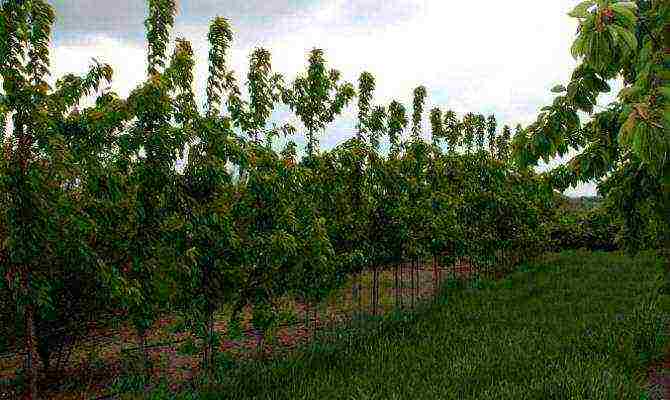
Columnar fruit trees
And only a few of them, such as the yellow Fatezh cherry, have a relatively moderate growth.To breed low-growing sweet cherry varieties, modern breeders have used several methods of suppressing the dominant gene of tallness. We will tell you about two of them.
- Growing dwarf donors. Cultivated large cherries are usually grown on antipka seedlings, which are vigorous rootstocks. Low-growing rootstocks are used to reduce the height of the tree. Clonal cherry rootstocks known today have a wide range of possible crown reduction, which is 20-90%. The effectiveness of the use of low-growing rootstocks has been noted by world breeders, industrial gardeners and private farms. Thanks to the latest research, the prospects of using dwarf cherry rootstocks were confirmed, which influenced the further development of breeding work in this direction.
- Exposure of test specimens to radiation. This method is based on causing a mutation in plants that suppresses the dominant traits of their tall stature. As a result of the work of Canadian specialists, low-growing varieties of cherries were bred - dwarf Compact Lambert and Compact Stella. The resulting columnar forms have earlier periods of full fruiting than large-fruited tall cherries.
But, despite many advantages, even the best columnar varieties have a number of disadvantages. Flower buds of low-growing cherry rootstocks have low resistance to spring frosts, which often leads to a noticeable loss of part of the crop. In addition, the buds of dwarf trees bloom earlier than those of tall plants, which can lead to the threat of freezing.
Another significant disadvantage of the columnar sweet cherry is its over-yielding capacity, since the fruits ultimately lose significantly in size, which affects their market value. To prevent this phenomenon, the crowns of columnar trees need regular adjustments aimed at regulating the load on the crop.
Rate the article:
(1 vote, average: 4 out of 5)
If you cannot boast of a large plot, then when choosing a cherry variety for yourself, you should focus not only on its characteristics (yield, fruit weight, taste, resistance to pests and diseases), but also on its self-fertility.
Self-fertility is the ability of trees to bear fruit without cross-pollination with trees of other varieties. Self-fertile cherry varieties will have to be selected by those gardeners who own small plots and are not able to place several varieties blooming at the same time on them for mutual cross-pollination. Unfortunately, not so many varieties are capable of self-pollination.
We have selected the top 7 best self-fertile cherry varieties and ranked them in descending order of self-fertility (from the highest to the lowest value of this indicator). All these varieties will surely delight you with a decent harvest, even far from the "sister" trees.
It is important to understand that the yield of inter-pollinated cherry trees will always be higher than that of self-pollinated plants. This is a specific feature of the culture - in order to obtain the maximum yield variety declared in the description, the sweet cherry needs pollinating varieties.
Backyard yellow
This variety is the leader of our top, as it has the highest self-fertility among the known varieties of sweet cherry. Due to the fact that the size of the tree is medium, and the fruits are tasty and fragrant, the Home Garden is always a welcome guest on any, even a small garden plot.
The yellow color of the fruit will add charm and charm to the garden, decorate the table and diversify the gardener's diet. You won't have to wait long for the fruits - the trees quickly enter fruiting, are characterized by active growth and high resistance to both diseases and pests, as well as to winter frosts, and even spring frosts.
Sweet cherries of this variety will always provide you with a harvest, because its fruits hang on branches without crumbling or cracking even in rainy weather.
| Entering fruiting | Tree height (m) | Fruit weight (g) | Harvest | Pollinating varieties |
| For 5-6 years | 3,5-4,5 | 5,0-5,5 | Early July | Does not need pollinating varieties |
Bereket
This variety has a high self-fertility, however, to increase the yield, one or a couple of pollinator varieties can be planted with it. The variety was obtained at the very beginning of the XXI century, and therefore is characterized by all the characteristics inherent in modern varieties - high winter hardiness and drought resistance, as well as resistance to pests and diseases.
The trees of the Bereket variety are medium in size, they are suitable for any, even the most modest site. Plants quickly bear fruit and produce beautiful dark red fruits with juicy, surprisingly tasty pulp.
The undoubted advantages of the variety include the high transportability of the fruit, and the absence of the need for formative pruning of the tree, which makes it simply ideal for planting in the country.
| Entering fruiting | Tree height (m) | Fruit weight (g) | Harvest | Pollinating varieties |
| For 4-5 years | 4,8-5,3 | 5,6-6,3 | Start - mid June |
Self-fertile, but when pollinated varieties Iput and Revna the harvest increases |
Goryanka
The variety was bred in the last century, but this does not mean that it is morally obsolete. It will give odds to any, even the most modern cultivator, because its trees have restrained growth, resistance to drought and frost, as well as diseases and pests.
The fruits of this variety are quickly tied after flowering and ripen together, turning into elegant maroon "dresses" with a pleasant, juicy and very tasty pulp.
The variety is remarkable in that it gives good yields, even a single tree is planted on the site. The fruits can be transported over long distances without damage, and the seed in the berries is small and separates very well from the pulp.
The variety is suitable for cultivation in summer cottages and small farms.
|
|
||||
| Entering fruiting | Tree height (m) | Fruit weight (g) | Harvest | Pollinating varieties |
| For 4-5 years | 4,1-4,7 | 6,0-6,4 |
Start - |
Self-fertile, but when pollinated varieties Iput and Revna the harvest increases |
Tyutchevka
A modern cherry variety with a whole complex of useful and necessary signs for any summer resident is both sufficient self-fertility, and the modest size of the tree, and resistance to diseases, pests, frost and drought, as well as early entry into the season of fruiting and, of course, excellent taste and fruit color, which is good in compote, and fresh when full of sweet juice.
The fruits have a bizarre wide-rounded shape, a dark red "outfit" pleasant to the eye and surprisingly juicy, tasty red pulp.
The variety can be advised to plant on your site also because its fruits are very pleasant to collect. The thing is that their stalk is thick and rather long, and the berries themselves break away from it easily, almost without effort, and the ripe ones hang on the branches without falling, as if waiting for you.
Due to the fact that the fruits are well transported, you can easily take them from the dacha to the house.
| Entering fruiting | Tree height (m) | Fruit weight (g) | Harvest | Pollinating varieties |
| For 4-5 years | 4,0-4,3 | 5,3-7,4 | End of June - early July |
Self-fertile, but when pollinated by varieties Ovstuzhenka or Raditsa the harvest increases |
Dunn
A rare variety that can boast a complete lack of flaws, Dunn is one of them. The trees stand out among others for their luxurious pyramidal crown, which practically does not thicken and requires only sanitary pruning, for its highest resistance to winter frosts and spring frosts, as well as to pests and diseases.
It is worth planting at least one seedling of the Dunn variety on your site, as soon you will get a good harvest of large and aligned, like a ruler, fruits of a pleasant dark red color. And their flesh will be juicy, tender and so pleasant to the taste that you will eat all the berries unnoticed.
| Entering fruiting | Tree height (m) | Fruit weight (g) | Harvest | Pollinating varieties |
| For 4-5 years | 4,0- 4,7 | 4,5-4,9 | Start - mid June |
Self-fertile, but when pollinated varieties Iput and Revna the harvest increases |
Dolores
A variety with a romantic name that will not leave anyone indifferent. It will come in handy for hurry gardeners who are not used to waiting for a long harvest, for those who do not want to use a stepladder to pick every last berry, and for those who wish to see healthy and luxuriantly blooming plants when they come to the dacha or return to the garden in spring.
Those with a sweet tooth will not be disappointed either - Dolores fruits have all the qualities to satisfy the taste of even the most fastidious cherry lover. Each fruit, like a fresh candy, is “packed” in a maroon wrapper and contains a small, almost invisible bone, which is hidden in a juicy, tasty and fragrant burgundy pulp with a piquant sourness, which does not spoil at all, but on the contrary, gives the taste sophistication.
The fruits are suitable for all types of processing, and the trees are suitable for planting in any, even the smallest area.
| Entering fruiting | Tree height (m) | Fruit weight (g) | Harvest | Pollinating varieties |
| For 4-5 years | 3,5-3,8 | 5,5-6,2 | Mid june | Self-fertile, but when pollinated varieties Iput and Revna the harvest increases |
Pridonskaya
This variety closes our top 7. But do not think that he does not have sufficient self-fertility to produce crops, even if you have a single tree growing on your site. It's not like that at all. Despite the partial self-fertility, the Pridonskaya cherry will supply you with a harvest in the form of very large, one-dimensional fruits of a rich bright red color with pink, slightly gristly and very juicy pulp of a pleasant, refreshing sweet and sour taste.
The variety is also valuable because its yield is stable and annual, because the flowers are not afraid of spring frosts, and the plant itself is not afraid of severe frosts and summer heat.
The variety is suitable for growing both in the country and in an average-sized garden, its trees do not require any pruning except sanitary, and no protection, because they do not get sick and are extremely rarely affected by pests.
| Entering fruiting | Tree height (m) | Fruit weight (g) | Harvest | Pollinating varieties |
| For 5-6 years | 3,8-4,5 | 5,0-6,5 | Start - mid June |
Self-fertile, but when pollinated varieties Iput and Revna the harvest increases |
We have considered the most interesting varieties of cherries that deserve the attention of both amateur gardeners and professionals. The listed varieties have all the features inherent in modern varieties and, moreover, are characterized by high self-fertility, which will allow you to grow on the site not only cherries, but also plants of other breeds. Do not forget that planting trees of self-fertile varieties, like other stone fruits, is best in spring.
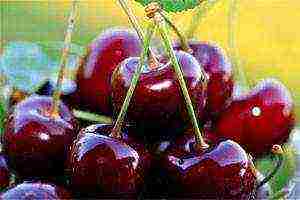
There are more than three thousand varieties of sweet cherries all over the world. Trees live and bear fruit for a long time. With good care, cherries can delight more than one generation of gardeners; there is evidence of fruit-bearing trees that have reached a hundred years old.
Cultivars differ in flowering time and fruit formation, frost resistance of trees, their height and crown shape. Berries have different tastes, differ in appearance: color, shape, length of the stalks.
A novice gardener who decides to plant trees on the site should consult in advance with experts on the cultivation of the selected variety. And we will try to describe the characteristics that you should pay attention to before purchasing planting material for your site.
Tree height
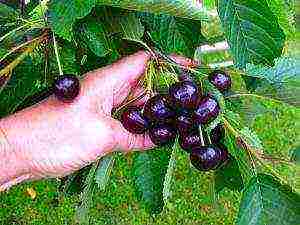
Cherry variety Revna
Distinguish in height:
- vigorous;
- medium-sized;
- low-growing varieties.
An adult cherry plant is a large tree with large lateral branches and a spreading crown. In nature, cherries can grow into a 20-meter tree. A cultivated plant rarely reaches a height of 7 meters. However, this property - height and the never-ending desire to grow upward, create considerable problems for gardeners.
That is why breeders do not stop working on breeding undersized or dwarf varieties, varieties with a weeping crown. New varieties are obtained by free pollination, crossing with cherries, growing cherry-cherry hybrids.
The most famous result of this selection is the Valeria variety. For experimental purposes, young shoots are exposed to radiation. Thus, the varieties Compact Stella and Compact Lambert were obtained by Canadian scientists.
However, a stunted plant, as a rule, tolerates the cold worse, requires more careful care, and is less viable.
Take a note: At present, the most effective way to obtain dwarf, undersized and medium-sized trees is the cultivation of cherries on clonal rootstocks.
Frost resistance

Sweet cherry varieties Francis
According to cold tolerance, trees are divided into:
- winter hardy;
- medium winter resistant;
- varieties with low winter hardiness.
It is worth remembering that sweet cherry is a thermophilic tree that naturally grows in areas with a moderately warm climate. The bark of trees is capable of withstanding frost of 20-30 degrees, but at the same time fruit buds are exposed to the danger of freezing. It is not uncommon for the buds, in which the rudiments of pistils and stamens are frozen, to retain the rudiments of petals. Therefore, after a frosty winter, flowers bloom on the branches, but they do not leave berries behind.
It is also possible to grow cherries in the gardens of the central zone of Russia. Through the efforts of breeders, winter-hardy and medium-hardy varieties have been obtained. In the State Register of Breeding Achievements in the Central Region, 14 winter-hardy species of sweet cherry are noted. Among them, the most popular are Leningradskaya Black, Rechitsa, Chermashnaya, Iput.
But for those who want to grow this berry in the north-western regions of the country, unfortunately, there are no officially registered, verified, zoned varieties yet.
Interesting fact: there are a small number of varieties grown by amateur gardeners as an experiment. The best among them are Seda and Yurga.
Pollination

A bee pollinates a flower
According to the ability to self-pollinate, it is customary to divide trees into:
- self-fertile (the most popular variety is Narodnaya Subarova);
- partially self-fertile (varieties Revna, Ovstuzhenka);
- self-infertile (Fatezh, Valery Chkalov, Chermashnaya).
A self-fertile fruit tree variety does not need other varieties of pollinators. Such trees do not depend on the number of bees and insects involved in the distribution of pollen. These are trees that can self-pollinate, or rather, in place of 20-40% of flowers, an ovary is formed, and in the future, fruits. These trees can grow on their own. Unfortunately, there are very few self-fertile cherry varieties. Or more often they belong to the partially self-fertile varieties.
In most cases, cherries are not capable of self-pollination. In order for fruits to form in place of flowers, it is necessary to plant several varieties next to each other, blooming at the same time.
Note: to improve pollination, the branches are sprayed with a sugar solution before flowering. Sugar does not affect the growth of the plant in any way, just its sweetish smell attracts bees.
However, when planting trees, "neighbors" must be selected. not all varieties are compatible. The Iput variety has proven itself as such a pollen distributor. But remember that no one cultivar is the optimal pollinator for other cultivars.
Berry ripening time
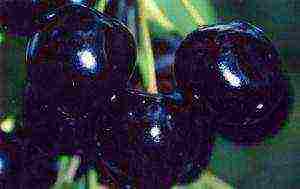
Cherry Leningradskaya black
Cherry varieties are usually divided into:
- very early. These include Early Ruby, Early Stamps. These varieties bear their first fruits by the end of May;
- early;
- early-middle;
- mid-late;
- late, which include large-fruited cherry, Raisin, Drogan yellow. Ripen in early July.
Berry color
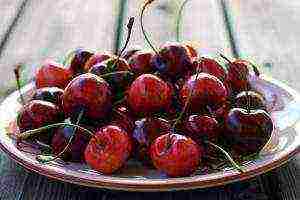
Sweet cherries of different varieties
The color of the berries can be from orange, yellow (oddly enough, this berry is often called white) to dark cherry, black.
- black cherry, more precisely, its color is dark red. An example of such a sweet cherry can be Melitopol black;
- cherry with pink fruits. The color of the berries is fixed even in the names of varieties: Leningradskaya pink, Pink pearls, Bryanskaya pink, etc .;
- yellow (white). The most common varieties of yellow (white) cherries are Chermashnaya, Drogana Yellow, Radiant light.
Fruit shape and weight
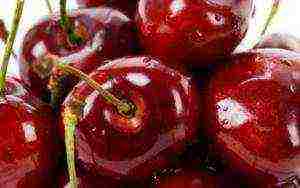
Large cherries
By fruit size, cherry cultivars are divided into:
- large - weighing more than 5 g. These include: Revna, Drogana yellow, Tyutchevka, Iput, Raditsa, Sadko;
- medium (3-5 g);
- small (up to 3 g). Berries of these varieties are more like large cherries, but they have a sweet taste. Varieties with small berries include Early pink, Leningrad pink.
The shape of the berries is usually round, but there are varieties with a heart-shaped shape that is slightly flattened on the sides.
According to the hardness of the fruit, it is customary to divide the berries into bigarro and gini. If the fruits are soft, tender, with a thin skin, which quickly leave traces of touching, pressing, light bumps against each other - you are dealing with varieties of gini. As a rule, these are berries of early maturing varieties. These trees will delight you with flowering and the first berries by the end of May, but such varieties poorly retain their presentation, are practically not transportable.
Bigarro - dense berries with cartilaginous pulp, streaked, are of great industrial value, because possibly for longer storage, adapted for transportation, widely used in conservation, production of dried fruits.
How to grow various varieties of sweet cherries on the same tree, planting it using the improved copulation method, see the following video:
Rate the article
(
estimates, average:
out of 5)
Sweet cherry is a southern culture. Previously, the middle region of our country was not suitable for growing this berry, and all because this plant did not survive in the harsh winters. Complex logistics, transportation costs, time - all this increased the cost of the final cost of the berry and made it truly "golden".
The most heart-healthy product
Today, breeders have developed many varieties that can grow in the northern regions. Yes, the yield will be less, the fruiting period is shorter, but the taste will not change from this. And how to choose cherries for the Moscow region, the best variety of which everyone determines for himself, you will learn from our article.
Choosing a fruitful cherry variety for the Moscow region
First of all, it is worth noting that this tree itself is very finicky, and even more so in conditions that do not meet the requirements of its growth. Some time ago, a large-scale destruction of cherry orchards was observed in the Moscow region, which served as the development and cultivation of new varieties of cherries. The best varieties of cherries and cherries, which can be grown in the northern regions of Russia, have not only excellent taste, but also disease resistance.
Most varieties tolerate transportation well.
The best cherry varieties for central Russia can grow fully under the following conditions:
- "Sparing" frosts;
- lack of sharp temperature changes;
- ensuring a sufficient amount of light and heat during flowering and ripening of fruits;
- timely care, cultivation and watering;
- regular fertilization of the soil.
The best varieties of cherries that can be grown in the Moscow region do not tolerate both early and late frosts in the autumn and spring seasons, at a time when the sap flow either has not yet ended or has already begun.
To increase the yield of cherries, regular fertilization of the soil is imperative. Otherwise, the fruits will be small and not juicy.
Today, every experienced gardener is already familiar with all the best varieties of sweet cherries that can be grown in the Kuban, Krasnodar and Altai Territories.Whereas inexperienced landowners will probably be interested to know what species of this plant can easily grow in cold regions.
Read with this article: Wood ash as soil fertilizer
Rating of the best varieties of sweet cherries by yield
The best varieties of cherries for the Moscow region, the forum about which allows you to find out all the details of growing this berry, have already managed to prove themselves well as the most persistent and fruitful. But at the same time, you should not completely trust the breeding data and let the cultivation of a thermophilic tree take its course. To get an excellent harvest, it is worth taking care of both the process of planting the seedling and the timely fertilization of the soil. This is the main condition for obtaining high yields.
Narodnaya Syubarova
One of the best self-fertile cherry varieties for cultivation in the northern regions is distinguished by the fact that it takes root in almost any climatic zone. The five-year-old tree has a well-developed branching system and trunk. And the crown of such a plant is strong, capable of protecting internal tissues from frost and other negatively influencing factors.
Variety Narodnaya Syubarova
Saplings of the People's Subarovaya cherry take root in the Crimea, Ukraine and even in the Volgograd region and have a unique resistance to coccomycosis. High-quality maturation is possible both in loamy and sandy loam soil. Such a plant belongs to the self-fertile group that does not need the help of other pollinating trees.
The large fruit has a juicy burgundy flesh, a pleasant sweet taste, while the rind is distinguished by a waxy bloom. The berry is harvested from a four-year-old seedling. Fruit weight fluctuates within 4-6 grams, and a large harvest can be obtained from a tree - up to 50 kg of fruits. This variety can be said to be "quality + quantity". The ripening period is the end of July.
Iput
Self-fertile sweet cherry, mid-season, begins to bloom in the second decade of May. But the harvest takes place in the first ten days of July. Decorate any garden with its beautiful and voluminous deciduous system. The fruits are burgundy, rarely dark pink. And if the site is well fertilized, then they can have a practical black color. The frost resistance of this tree is extremely high.
Variety "Iput"
The berry is large, weighing up to 6 grams. But in order to grow this type of plant, you need to adhere to all the rules and techniques of agrotechnical care for it. The tree is not pollinated, so it is extremely important during the period of ovary formation to make every effort to lure insects onto it. This is the only way to get a high yield.
Ovstuzhenka
The best cherry variety for the Moscow region, reviews of which are only positive. This is due to the high level of cold resistance - the plant is able to withstand frosts down to -45 ° C. Due to the fact that the height of the tree is no more than 2.5 meters, it is most often planted on an industrial scale.
Ovstuzhenka
The berries are dark red and can weigh up to 6 grams. Begins to bear fruit in the fourth year of growth. Up to 25 kg of fruit can be harvested from a tree. This frost-resistant species is very popular with both experienced gardeners and beginners. Tyutchevka, Ipun, etc. are suitable for pollination.
Cheryomashnaya
This is a southern hybrid species, the height of the trees of which reaches 5 meters. The berries are yellow in color, medium in size and oval in shape. In sultry heat, the fruits may be with a pink barrel. Due to its good winter hardiness, this species is able to grow in the Moscow region and adjacent regions. A distinctive feature of Cheremashnaya is its high resistance to various fungal infections. Pollinating varieties - Ipun, Valery Chkalov, Priusadebnaya yellow, etc.
Cheryomashnaya
Description of the species: fruiting begins in the fifth year of ripening. The weight of one berry reaches 4.5 grams, and up to 27 kg of fruits can be harvested from one tree.
Jealous
The plant has a pyramidal form of development of the deciduous system. For the most part, this variety decorates "home" gardens. The tree bears many fruits, and, despite its small size, they are distinguished by excellent taste and unique aroma. During the flowering period, the fruit seedling is able to withstand minor frosts - up to -7 ° C.
Jealous
Distinctive feature:
- long shelf life;
- high resistance to fungal infections.
The berry has a maroon color, juicy and firm. The beginning of fruiting occurs in the fourth year of growth. The crop is ready to be harvested in the first decade of July.
Tyutchevka
Differs in high fruiting. The fruits are maroon, and sometimes even black. Distinctive feature:
- long peduncle;
- good transportability;
- long shelf life;
- large berry sizes - up to 7 grams;
- pleasant, tasty aroma and honey taste;
- self-pollination.
Backyard yellow
A tall seedling that grows up to four meters over three years. The berries are large, slightly elongated and bright yellow in color. A type of early ripening period, it is able to maintain resistance to prolonged frost. Differs in good productivity and resistance to typical diseases of fruit trees.
Backyard yellow
The beginning of fruiting occurs in the sixth year of ripening. Whereas the first sweet cherries can be harvested in the second decade of July. The weight of the berry is up to 6 grams, and up to 60 kg of the crop can be harvested from one tree.
Now you know which cherry varieties are better to plant in the Moscow region. We hope these tips will help you make the right choice and grow beautiful and fruitful fruit trees in your garden.
Cow heart
A worthy example of the best cherry varieties for the Crimea. One of the largest, juicy, aromatic berries. Early flowering - May-June. Ripens in the middle of summer. Begins to bear fruit 5 years after planting the seedling. The yield is very high - an average of 100 kg per tree.
Cow heart
The variety is frost-resistant, not susceptible to attack by insects and fungi. Requires fertile soil and deep soil. It can die within a month if the root starts to rub against hard rocks.
VIDEO: The best varieties of cherries


